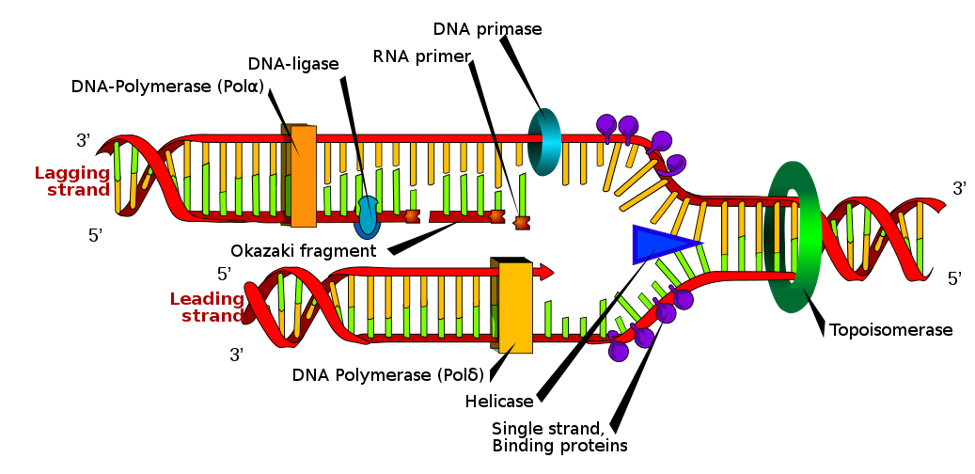As we all know every new cell is formed from pre-existing cells. Even a new cell gets its DNA from preexisting cells. In order to fulfill the requirement of DNA for the new cell, DNA must be gone under a process, and multiply this process is known as DNA replication. We all know that DNA contains all the genetic information of our body (each cell of our body).
DNA replication was initially proposed by WATSON and CRICK. They said it involved the distortion of hydrogen bonds.
![]()
The double-helix model of DNA given by Watson and Crick suggests that the nature of DNA replication is semiconservative. Means when two strands start unwinding then each one of the strands serves as a template for the new strand.
In the above picture, we can see that blue one is the parent DNA, that is serving as a template for new strands of DNA.
DNA replication STEPS: (Prokaryotes)
- If we compare DNA to a chain, the 1st step is to unwind or unzipping the helical chain.
- The process is carried out by an enzyme named Helicase (helicase use ATP to unzip the DNA).
- When Double helical DNA gets unwind helix has to rotate it creates topological stress at a point to release this stress there is a key enzyme named as topoisomerase that helps to release the stress.
- The separation of helix creates a ‘Y’ shape structure that is known as the replication fork.
- These both unzipped strands will act as a template for the new strands of DNA.
- Once both the strands are pulled away, they must have prevented from going back together. So, there is an enzyme named SSB (single stranded-binding proteins) that helps single-stranded DNA from being coiled again and forming a double-strand DNA again.
- The strand oriented towards 3`-5` is known as the leading strand.
- The synthesis of DNA begins with an enzyme named DNA polymerase. DNA polymerase is not capable of syntheses DNA alone, so it needs a 3’OH and starts adding DNA nucleotides.
- The 5’ phosphate is joined in every upcoming nucleotide by DNA polymerase at the 3’OH end of the rising chain.
- Primers (a short piece of RNA) are produced by an enzyme named PRIMASE binds to the end to the leading strand.
- The other strand in direction 5’-3’ known as a lagging strand (forms Okazaki fragments).
- Synthesis of the Lagging strand requires multiple RNA primers. Nucleotides are attached in many short pieces joined later and these short fragments of nucleotides are known as OKAZAKI fragments.

- Once the process of adding nucleotide is finished an enzyme named Exonuclease strips the primer.
- Et the end DNA Ligase seals up the sequences and again forms two double-stranded DNA.
- In prokaryotes there are 3 types of DNA polymerase:
- DNA polymerase I
- DNA polymerase II
- DNA polymerase III
Eukaryotic replication:
We all know that our DNA is very complexed and well developed. Replication in eukaryotes is a complex process because of our genome. in eukaryotes, the structure and packaging of the genome are very complexed in comparison to prokaryotic DNA. Process of replication in eukaryotes is divided into 3 stages:
Initiation:
Eukaryotic DNA is bonded to a protein known as Histone, forms a structure called a nucleosome. During the initiation, the DNA is available to the protein and enzymes which are involved in the replication. There are some specific chromosomal locations called the origin of replication (ORI).
Certain enzymes recognize and bind to the origin of replication and other proteins bind to the ori.
Helicase came and starts unwinding the DNA.
****Role of other enzymes are same as prokaryotes****
Elongation
in elongation, there are polymerase alpha (Pol α), DNA polymerase delta (Pol δ), and DNA polymerase epsilon (Pol ε).
Primase starts adding nucleotides.
Termination:
to remove the RNA primers there is a group of enzymes that works together: FEN1 (flap endonuclease 1) and RnaseH.
Differences between prokaryotes and eukaryotes based on DNA replication
| S.NO | Prokaryotes | Eukaryotes |
| 1 | Replication in prokaryotes is a continuous process | Replication occurs in the S phase of cell cycle |
| 2 | Replication takes place in the cytoplasm | Take place in the nucleus |
| 3 | DNA is circular | Linear DNA |
| 4 | A lesser amount of DNA | Very high and complex DNA |
| 5 | DNA polymerase is:
Pol. I, Pol. II, and Pol. III |
DNA polymerase is:
Pol α, Pol δ, and Pol ε |
| 6 | Okazaki fragments are large (1K-2K nucleotides) | Short Okazaki fragments (100-200 nucleotides) |
| 7 | Rapid progression around 2000 nucleotides per second are added | a slow progression of 200 nucleotides per second |
| 8 | Single-origin of replication | Multi origin of replication |
Thanks